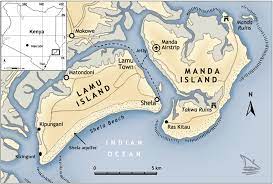The frequency of terrorist attacks within Kenya’s Lamu County on the border with Somalia has been alarming. Frequent kidnappings there were the ostensible reason Kenya invaded Somalia in 2011. Three years later, the seaside county was the scene of a deadly attack in which 48 were killed during an Al-Shabaab siege.
Lamu is in the news again. In January this year, the government declared a dusk-to-dawn curfew amidst a wave of killings. Several terrorist attacks have also been carried out.
Here are the five reasons why Lamu County is a constant target of Al-Shabaab militants:
1. Unique topography
The natural and physical features of Lamu county offer an ideal setting for political violence, including insurgency and terrorism. It is one of the counties that border Somalia. Its expansive Boni Forest comprises about 21.4% of the county’s land area.
Lamu’s proximity to Somalia, and the Boni Forest, therefore makes it conducive for Al-Shabaab’s infiltration. The forest provides a haven for military training and a staging point for hit and run tactics.
The short distance to Somalia also makes it easy for terrorists to move illicit weapons that can be used for such crimes. Hotspots of violent extremism and terrorism in Lamu include, Pandanguo Basuba, Boni Forest, Pangani, Gamba, Milihoi, Bargoni, Mpeketoni, Amu, Witu, Kiunga, Faza, Pate, Siu and Dar es salaam Point
2. Land Tenure
Competition for land is another significant factor that creates opportunities for Al-Shabaab operations in Lamu. Land disputes in Lamu are historical and contemporary. The tensions between the indigenous and non-indigenous communities are influenced by several historical and contemporary factors. In Mpeketoni, the scene of the deadly 2014 attack, land disputes spring from the settlement of communities from other parts of Kenya.
Topping this list is local level politics. Local leaders tend to politicise land ownership. This is due to the perception that non-indigenous communities in some parts of the county have significant influence on local political decisions and electoral outcomes.
This politisation fuels land grievances and political intolerance. This leads to the emergence of organised militias at the local level. This provides ideal conditions for Al-Shabaab to advance its agenda – by using such militias as proxies and affiliates.
Non-indigenous communities often complain that some of the attacks are conducted by locals who appear to have military training.
3. Religious diversity
Related to the settlement tension is the issue of religion in Lamu. Originally, the county was overwhelmingly Muslim like other counties bordering Somalia – Garissa, Mandera and Wajir – where 98% are Muslim.
However, the historical and contemporary migration of non-indigenous communities have contributed to religious diversity in the county. Today the Muslim population comprises 51%, Christian 47% and other religious groups at 2%.
The religious diversity provides an ideal opportunity for Al-Shabaab to advance its divisive political ideology through radicalisation of the local population. Attacks seek to symbolise the militants’ ideological aims and objectives of creating an Islamic Caliphate in the Horn of Africa.
Al-Shabaab also often targets non-Muslims in the hope of creating interfaith tension. That is why Al-Shabaab prefers to attack areas that have large non-indigenous populations.
4. Tourist attractions
Al-Shabaab’s operations target Lamu because of the symbolic significance of tourism in the county. The county is one of Kenya’s top beach, festival and agro-tourism destinations. This is because of its rich marine ecology, terrestrial wildlife and pristine beaches. Others are water sports, cultural and heritage assets as well as its religious, cultural and food festivals.
More significant is that Lamu County is a popular destination for tourists from various Western states. Al-Shabaab targets tourists from Western states in Lamu and other coastal areas for both symbolic and economic reasons.
As part of its war tactics, the attacks involve kidnapping tourists for ransom. They are also designed to attract international media attention.
The group requires such a profile as part of its financing strategy. It is also part of Al-Shabaab’s strategy of sabotaging both the Lamu’s and Kenya’s economy.
5. High-profile projects and military bases
Al-Shabaab’s attacks also target large-scale development and defence infrastructure. The most notable public project is the Lamu Port-South Sudan-Ethiopia Transport corridor (LAPSSET). This project which seeks to link Lamu port to South Sudan and Ethiopia – via rail and roads – is the single largest infrastructure undertaking in the eastern Africa region.
Other targets include military personnel and assets stationed in Lamu. They include Kenyan and US military bases at Manda Bay. The Kenya Navy Manda Bay base serves as a national, regional and global military installation.
Given that Al-Shabaab is now a transnational actor, and a threat to domestic and regional security, Manda Bay base has been used as a launching pad for several major counter-terrorism operations.
The Manda Bay military facility is also used by the US Department of Defence as a forward operating location. It falls under the operational control of the Combined Joint Task Force-Horn of Africa, based in Djibouti.
Lastly, attacking Lamu port, and the military facilities used by the Kenya Defence Forces and the US military, is part of Al-Shabaab’s symbolic response to Kenya’s state-led development initiatives and global counter-terrorism operations.
On January 2020, Al-Shabaab attacked Manda Bay and killed one US military service member and two contractors. The militants also destroyed aircraft and infrastructure. This was Al-Shabaab’s first and most fatal attack, beyond Somalia, on a US military facility in Africa since 2017.
The article first appeared on The conversation
Statements, comments or opinions published in this column are of those of the author(s) and do not necessarily reflect the editorial policy of Warsan magazine. Warsan reserves the right to moderate, publish or delete a post without prior consultation with the author(s). To publish your article or your advertisement contact our editorial team at: warsan54@gmail.com

